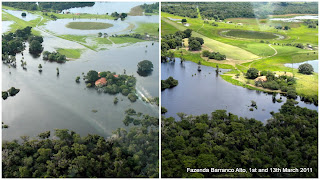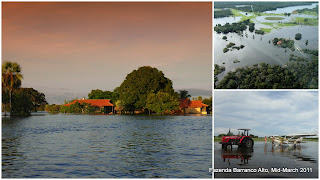For the first time today the water of the Rio Negro didn´t rise anymore. We might be coming to the apex of the flood. This is the biggest ever measured flood in this area of the Pantanal.
Over the past 2 weeks the water rose daily, sometimes 50cm in 24 hours. The rains were heavy, in 12 days more than 520 mm, this on top of all the fallen rain in december/january. On the photos taken on the 1st of March (right) and later on the 13th of March 2011 (left) the difference of the water level is remarkable. The lodge (mid-right) is an island and the runway is partially flooded in. Note that the right photo is already a "wet" one, that means what we consider to be the peak of a normal flood.
Following you can see the lodge "island" and us towing the airplane to a higher part of the runway after a rainy (45mm) night.
Again, one has to point out that the flood is a highly beneficial act of nature. It reinvigorates the Pantanal´s exuberance of life. It restocks lakes and river with fishes and it keeps open grasslands "clean" from shrubs.
Last but not least, it is a very healthy lesson to us humans who live in this natural paradise, teaching us to be humble towards our environment.



























